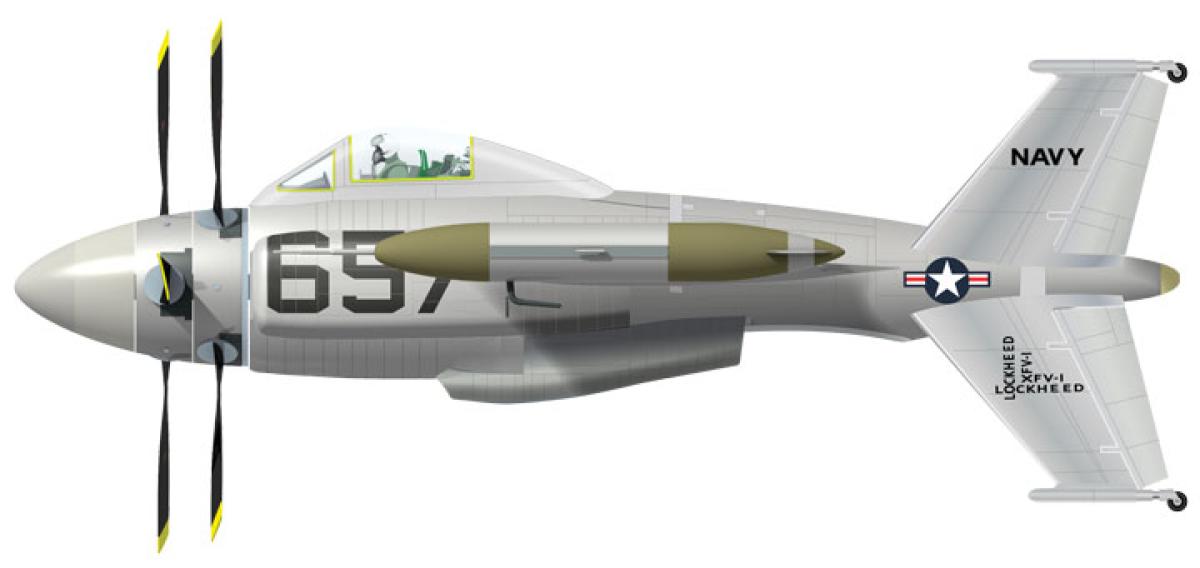A plethora of advanced aviation technology became available in the aftermath of World War II, as the Allies searched through the wreckage of German design bureaus, factories, and research institutes. British aviation expert Bill Gunston described what he considered the most radical project discovered in the Focke-Wulf project office at Bad Eilsen:
Though it never got beyond the stage of paper and a desk-top model, the Triebflugel was a remarkable amalgam of new ideas, which might even have worked. It was a target-defence interceptor, which stood on its tail pointing vertically upwards. It had no wings; instead a rotating collar around the mid-fuselage carried three slender airfoils, which could be regarded as wings or rotor blades. On the tip of each was a Pabst ramjet.1
The Triebflugel—translated as “thrust-wing fighter”—was designed in 1944 for the air defense of the Third Reich against U.S. and British bombers. Some models apparently were wind-tunnel tested before the war in Europe ended in May 1945.
Such a radical concept as a vertical-takeoff-and-landing (VTOL) aircraft was of great interest to the Allied air forces because of the vulnerability of airfields in Europe to Soviet air and, in the future, most likely missile attack. To the U.S. Navy in the late 1940s, the VTOL concept was of interest for shipboard defense: Could a practical “tail-sitting” VTOL aircraft be developed that could be based on surface ships—naval and possibly merchant—for the air-defense role?
In 1947 the U.S. Air Force and Navy issued study contracts for VTOL aircraft to industry, seeking to identify technologies that could provide such an aircraft. On 21 July 1950, these early efforts led to the Navy issuing a request for bids to design and build one. That December five firms responded—Convair, Goodyear, Lockheed, Martin, and Northrop.
On 31 March 1951, the Navy issued a contract to Convair for the development of a turboprop-driven VTOL fighter, to be designated XFY-1. Three weeks later a contract was awarded to Lockheed for an alternative design for a VTOL fighter—designated XFO-1 (later changed to XFV-1).2
Both prototype designs would employ the Allison YT40-A-14 turboprop engine. This was essentially two Allison T38 engines mounted side-by-side and geared to turn three-blade, contra-rotating propellers on coaxial shafts. It was envisioned that eventually the aircraft would have the more powerful XT40-A-16 engine with a military rating of 6,955 shp.
But the Lockheed and Convair designs were very different. Designed under the guidance of Art Flock, the XFV-1 featured short, highly loaded straight wings that were slightly tapered, similar in appearance to those of Lockheed’s F-104 Starfighter. A four-fin, cruciform tail was provided. Small, caster wheels were attached to the extremity of each tail surface for landing and flight-deck maneuvering.
The XFV-1 was sometimes referred to as the “Salmon” after Lockheed’s chief test pilot, Herman “Fish” Salmon. It was fitted with a temporary, non-retractable undercarriage featuring twin, long, braced V-legs attached to the fuselage and fixed wheels attached to the two lower tail surfaces for taxi and initial flight tests.
The plane began ground tests at Edwards Air Force Base, California, in November 1953. Salmon made a brief, unscheduled test hop on 22 December, but the first official flight in this “wheeled” configuration did not take place until 16 June 1954. Several technical difficulties caused the flight delays. Among the many problems were determining how the pilot would know his height above the deck when landing, what the correct landing speed would be, and how an ejection seat would function with the aircraft’s tail configuration.
From June 1954 through June 1955, the XFV-1 made 32 test flights totaling 23 hours. No takeoffs were made in the vertical mode, although on several occasions the aircraft transitioned to vertical flight and back to the horizontal, and it did hover briefly at altitude, hanging by its props. The plane’s predicted performance—even without the undercarriage apparatus—would be inferior to conventional fighters and some jet-propelled bombers. Coupled with continuing technical problems and the need for specially trained and experienced pilots to fly the aircraft, the project was cancelled in June 1955.
Only one of the two planned XFV-1 prototypes was completed. The proposed FV-2 production aircraft was to have had the more-powerful engine, air-intercept radar fitted in the nose dome, and wingtip pods housing an armament of four 20-mm cannon or 48 2.75-inch unguided rockets.
After the XFV-1’s demise, efforts were made to build on the limited experience of the program for vertical/short takeoff and landing (V/STOL) projects. Hiller Helicopters obtained the XFV-1 program’s two YT40-A-14 turboprop engines for use on their X-18 V/STOL cargo aircraft, a tilt-wing convertiplane that was also unsuccessful. And Ryan Aeronautical adopted features of both the Lockheed and Convair tail-sitting designs and fitted a pure-jet engine to produce the X-13 Vertijet, another VTOL aircraft that also failed.3
Thus, none of these early VTOL and V/STOL concepts provided an operational aircraft. Not until the British-designed Kestrel and Harrier took to the skies was an effective V/STOL aircraft available.
Editor’s note: Mr. Polmar will describe the Convair tail-sitting XFY-1 in the next issue of Naval History.
1. Bill Gunston, “U.S. Navy prop-hangers,” Aeroplane Monthly (October 1974), 891.
2. See René J. Francillon, Lockheed Aircraft since 1913 (Annapolis, MD: Naval Institute Press, 1987), 351–54. The most comprehensive journal articles on these aircraft are Bill Gunston, “U.S. Navy prop-hangers,” 890–98; and Francis J. Allen, “Bolt Upright,” Air Enthusiast (January–February 2007), 13–20.
3. The X-18 was used in the development of the Hiller XC-142A tilt-wing aircraft.



